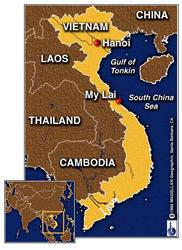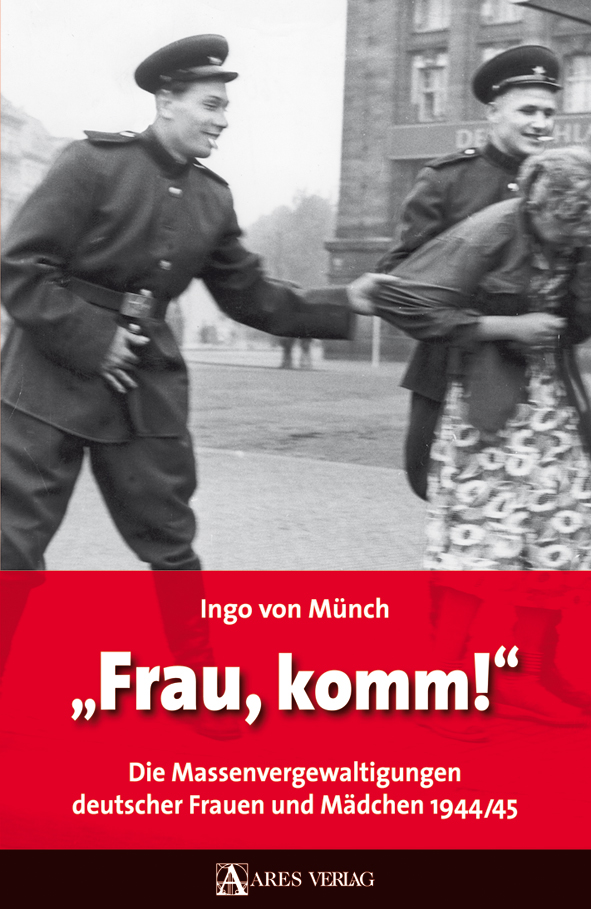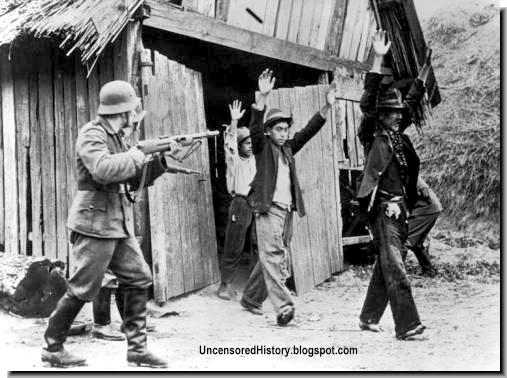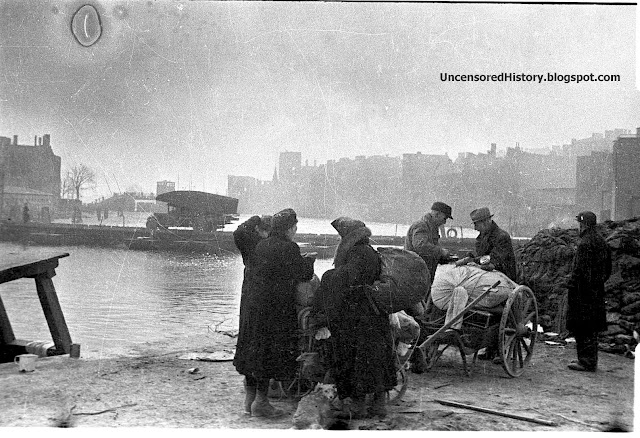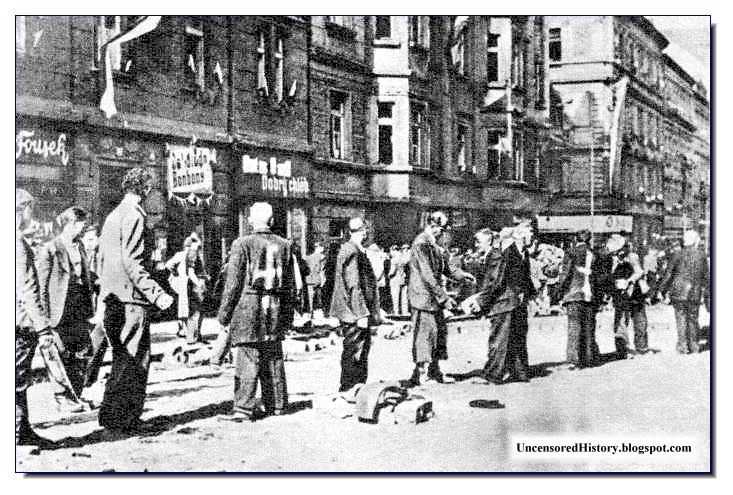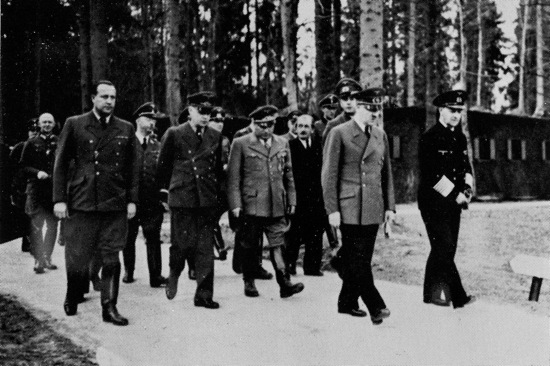 |
| American soldiers in My Lai after the massacre. In one of the photos Ronald Haeberle recorded a scene of two children, crawling on the banks of the rice fields to avoid the bullets. A few dozen meters away, lay about 21 bodies (mostly women, children) killed by American soldiers. Another black and white photos shows many Americans standing calmly on the banks of the rice fields after the massacre. |
43 years ago, on March 16, 1968, Ronald Haeberle a war correspondent went with American soldiers to the villages of My Son and My Lai, in Quang Ngai province. Here, U.S. soldiers killed 504 civilians, mostly women, children and the elderly. The shootings, murder and arson went on for four hours.
One year after the event, he decided to publish the images of the massacre in Life magazine.
Among the pictures he took in Son My village that fateful day, there are images that have not been released to the world before. He decided to introduce them to the world in 2011 through VnExpress a Vietnamese newspaper.
 |
| Tran Van Duc the survivor of the My Lai massacre lies injured. The arm of an American soldier is visible in the lower right hand side of the image. |
PERSONAL ACCOUNT OF A SURVIVOR OF THE MY LAI MASSACRE
I was born Tran Van Duc in 1962, the third child and oldest son in my family. My mother sold food at a local market and my father was a tailor, selling clothes and western medicine. He had previously been held captive by the government, and as a result we were all under constant surveillance, reporting to authorities daily.
We had a large house near Son My Market. On one side, our neighbor owned a lot of coconuts and stored them in his yard, and I can still remember how refreshing they used to taste in the heat. On the other side of our house, there was a large pond, where villagers cultivated shrimp and fish. Behind us was My Khe, where the sea and endless white sand seemed to stretch far into the distance.
--------------------------------------
"My Lai massacre has haunted, tormented forever my life "
Ronald Haeberle
--------------------------------------------------------
During my earliest memories of childhood, when the bombing raids commenced, my family became used to hiding in the ditches. Others were not so lucky, killed by collapsing tunnels as they attempted to emulate us. Many residents made the decision to flee My Son. Some went to neighboring Ly Son, others were separated and their whereabouts became unknown. Many children became orphaned and adults lost their homes. Fields and gardens were totally destroyed. Since my parents were in a fortunate position to provide help to those who had suffered losses, a number of families came to them in desperate need of food and shelter. As everybody left in search of safer grounds, we headed to Binh Duc, which due to its relative peace, seemed like paradise.
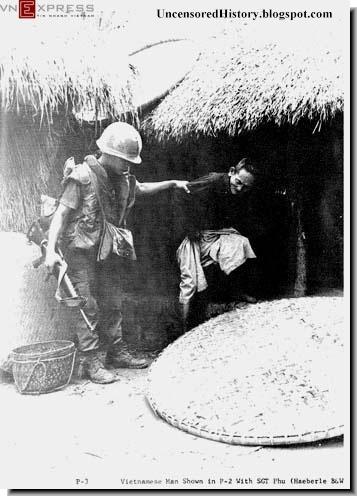 |
| An American soldier pulls out an old Vietnamese man to the front yard. Seems like "Platoon". |
With a population comprised mainly of fishermen and salt producers, Binh Duc seemed like a wonderful place. People here were very friendly and always smiled. Red and green colored boats appeared by the sea, ready for their day’s fishing. The shelling in Binh Duc was not as bad as the fighting in Son My. As the war started getting worse, our family lived with Mr and Mrs. Dong Hue for two years. My parents continued to operate their business in sewing and the wholesale market. I played with other children, waiting until the late afternoon for the sun to cool down, where we would catch crabs by the sea or play football with a plastic ball.
-------------------------------
"I remember the villagers were friendly. I most remember the children always smiled and waved when photographed. This prompted me to publish the truth."
Ronald Haeberle
-------------------------------
As the bullets rained and bombs fell constantly, the local market in Binh Duc came under heavy attack and we moved again, to Thuan Yen, where my younger sister, Thi Ha, was born. My family built a small house on the property of Mrs. Bo and my father worked in nearby Ting Hiep as a nurse in the district of Son Tinh C12.
Even as a child, I understood the threat and impact of war, a reality confirmed when my family was also forced to live apart from each other. It was hard for me to accept that my grandmother, who had lived all of her life in Son Hoi, lived alone. Her children all had their own families and had since moved. My parents took it upon themselves to take care of grandmother. I loved my grandmother very much, because she reminded me of my mother in both shape and character. My sister My Hong and I often delivered money for her to buy rice, something that excited me a lot, and I can still remember how warm her hugs were. The idea of running along with my sisters was always such fun, but it would not take long before I got too tired and asked for a piggy back ride.
 |
| A group of women and children were gathered together in one place. |
There was so much to like about travelling on the B24 road through Thuan Yen, which were lined with bamboo trees with a backdrop of the mountains. The villages, surrounded by wheat fields and rice paddies, were often dotted with people toiling hard in the rice fields, planting themselves deep into the mud. This road led to My Lai, a place where everybody seemed busy working out how to best cope with bombings. The village of My Lai had become a recent target for gunfire, and the safest time to undertake all activities was either early in the morning, which is when farmers tended to their rice and vegetable plantations, and watered and spread fertilizer on their crops. The only other safe time was late at night, as this is when the fewest shots reigned over the village. Consequently, daily life was frantic. Every day, residents woke early to greet the sunrise, for this is when family meals were prepared.
Even in such a hostile environment, nobody would have predicted the events that took place on that day, March 16, 1968. American military units fired artillery shots across Thuan Yen, My Khe, and My Lai for one hour. They sounded like fireworks. Our village and neighboring hamlets were completely surrounded. At 11:00 am, helicopters started flying over My Lai, and some people in the neighborhood heard rockets being fired. My family and I learned that some residents had already been injured by the shots because the rockets were flying flow and landed in rice paddies where people were working in the fields. I could hear people scream and cry in a high-pitched wailing sound. Any civilians who were caught were marched into the center of the village. It resembled a makeshift prison yard full of men, women and children.
 |
| An American soldiers chats with a little Vietnamese boy before the killings started. |
My father was not present in the household because he was away working in Ty Vinh Tinh Hiep, leaving my mother in charge of the household. Without any hesitation, she prepared an emergency kit for the children, fearing that we would also be taken from our hut. She hurriedly prepared a large brown canvas bag, placed some of my clothes in the bags and gave each of my siblings and myself 10,000 Vietnamese Dong, which we hid in our socks. I felt guilty about taking the money because it seemed like a fortune. We were then instructed to hide behind our house, which stored our home-made oils, medicines, textiles and fabrics. But before anybody had a chance to move, American troops stormed into our house and forced my mother, brothers and sisters to move onto the streets where everybody else was assembled. The last item my mother grabbed with her one free hand was her traditional straw hat, while desperately holding onto my baby sister, Thi Ha, with the other.
Once we were marched outside and told where to sit, my mother looked around and noticed the chaotic scenes where villagers were being pushed and shoved by soldiers. She noticed a nearby ditch near a neighboring house own by Mrs. Nhieu and told us all to move quickly, but to our dismay we found that it was already full. Crouching low, we eventually settled on a space near a tunnel opening. American troops were patrolling the area and continued to search tunnels. One old woman was struck on the lower back by a soldier’s rifle butt so hard, she fell to the ground in agonizing pain and could no longer walk. Horrified by what had just happened, I heard somebody say, “My God, we will all die.” This memory still haunts me today.
 |
| Soldiers interrogating the villagers. The mayhem had started. |
One attribute I always remember about my mother was that no matter how hopeless the situation looked, she never accepted defeat. From our ditch, she spotted a nearby bamboo bush and hinted to us that we should head towards it immediately. The children went first and she following behind us. But no sooner had we begun to crawl through the crowd of people that a soldier saw my mother amidst the crowd, stormed into the ditch and grabbed my mother violently, ripping her clothes. I cried loudly in the hope that she would not be shot. Without warning, gun shots were fired into the ditch, hitting a number of bodies. As bullets, blood and flesh flew everywhere, my mother covered her body with her straw hat while hugging my little sister Ha close to her breast, and with her free hand, pushed me in the direction of a ditch adjacent to neighboring rice fields. She ordered me to protect my sister Ha and pretend to be dead so that the soldiers would leave us alone. We were not to move unless we knew the area was clear. For what seemed like hours, my little sister lay on her stomach and I sheltered her by doing the same.
As soon as the American troops moved out, my older sister and I searched for our mother and found her. She was seriously hurt, having been shot in the head and I knew nothing could be done to save her. However, she still had enough energy to give us one last instruction: “Hug your sister Ha, and take her to Grandma’s house. Don’t stay here any longer or they may come back and shoot you.”
These were the last words I heard my mother speak, and whenever I think about that day, it causes me great pain because I loved her very much. It saddens me to accept that among the numerous dead corpses littered the path between the village and my Grandma’s house, one of them was my own mother.
There is a famous panoramic picture of corpses amidst a green rice paddy taken by U.S. Army photographer Ronald Haeberle. But it does not include a shot of the dead women and children behind him. This is because of his position inside the helicopter where the photograph was taken.
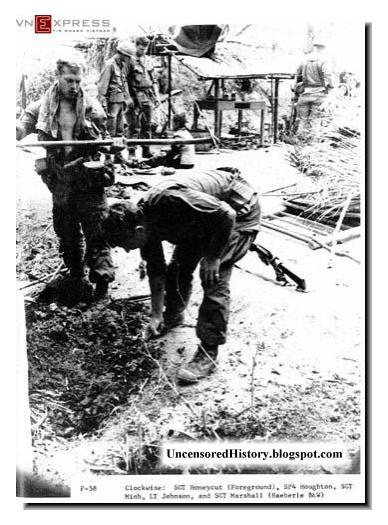 |
| An American soldier casually chucks a grenade into a basement shelter in Son My village. |
When we were far away from the tower, a low-flying helicopter appeared, preparing for landing. I was very scared and hugged my sister. We lay down on the ground out to escape overhead bullets being fired in our direction. When I looked up, I saw helicopters quite clearly and there were a few American soldiers. One unarmed soldier was sitting outside the door, taking photos of the scene. If he had fired bullets, my sister and I would have been hit because the chopper was flying close to the ground. Only when the helicopter disappeared, I embraced my sister, Ha, and headed for Truong Son, in search for the road to Hoi An. We came across several dead bodies of local men on their way to work or the market.
From a distance we heard the sound of the American soldiers’ heavy gunfire. Houses were also being burned, and thick black smoke rose in the sky. I sensed that the helicopters were still patrolling the region. But all I could think about was why the inhabitants of My Son, especially innocent children, were attacked and killed. Many good friends and relatives of My Lai had their roots here, yet the village was now destroyed, and what was once a happy village was now gone. In grieving for the people who once lived here, I repeated “Why were they to blame? Why did you kill her?” over and over again.
Part II
Before my sister Ha and I reached our grandmother’s house, we arrived in Gia Hoa to greet my uncle, and asked for drinking water. He saw that we were covered in blood, from hiding in between bloodstained bodies in the ditch before our mother directed us to run away. He cried, a sign of being frightened for our well-being, and then immediately called over a village nurse, Mr. Hung. Our injuries were obvious; I was wounded in the forehead and my sister Ha in the abdomen.
It was in this time we discovered that my older sister, My, survived the slaughter by falling into a ditch and covering herself with dead bodies of people shot in rice fields. She too was covered in blood, but none of us knew the other was still alive. In fact, confusion reigned as to the fate of our mother. Although she was laying in the ditch when I last saw her, another village woman had told My that my mother had in fact escaped and began looking for her other children in the fields.
We listened to My’s story. She shared with us how she wandered the path of other adults taking a wounded child to the village of Truong for emergency treatment at a makeshift clinic. The baby was near death, having lost a lot of blood. Seeing a lost child in the village, a local family invited My to stay with them overnight. This is how Ha and I came into contact with our sole surviving older sister. I was excited to see her, but my first question was about the fate of my other two sisters, Thi Hong (11 years old) and Thi Hue (5 years old). My relayed the news I did not want to hear — they had been shot by American soldiers.
 |
| The soldiers not only killed villagers but killed and destroyed livestock, poultry and food grains of the villagers |
I tried to imagine how my father would react upon hearing all of this. His working commitments in Ty Vinh Tinh Hiep saved his life on that day, but with Quang Ngai province in South Vietnam, not the North, the South Vietnamese government had labelled him “a revolutionary”, meaning that he would be killed on the spot if caught by either American soldiers or members of the Army of the Republic of Vietnam (ARVN).
It turned out that he had been informed of the massacre the day after it occurred and hurriedly set about returning home, but was too late to see his wife and two of his children get buried by his own cadremen. He concentrated on gathering information concerning the day’s events which led to their deaths. A few days later, he braved the drizzly conditions to see his mother (my grandmother), buoyed by the slim prospect of seeing two of my sisters and myself. Our reunion was emotional, and every month he returned to visit us and check on our condition. He dedicated his life to ensuring that his surviving offspring could have a better life and a chance at receiving an education. The task would have been impossible if some of his closest friends did not act as our guardians in his absence.
My grandmother was poor — very poor. Her bamboo house with painted walls in a village on the River Son Hoi did not feel like a permanent home. I used to have fond memories of coming here with my sisters and swimming in the river, but something seemed peculiar now. Maybe my soul had died. Grandmother was old and frail, and she relied on buying and selling fish in the market in nearby Loc. It was her main source of income, but not enough for all of us to live upon. My sisters and I asked Mrs. Bon Thuong, a family friend, to stop working at the markets and assist with making food. Since we experienced regular food shortages, I grew rice and wheat. For what was left of our family, this was the new life — no school, no fun, just struggle.
Every morning, my sisters and I would rise early to commence working on the farm and came back late. There were days when we had no food. Our skin was black and broken from toiling in the sun, and we were thin. I wore a torn hat and rags for clothing. My meager possessions included a pick-axe and a discarded Korean-made bag, which I used to hunt and gather food and anything else deemed edible. My aunts and other locals scavenged for rice, wheat, corn and fluorescent tubes. Any payment came in the form of Oi, a Vietnamese fruit, and some corn.
When I worked in the fields, my little sister Ha accompanied me. She was undernourished and cried a lot, for she missed breast milk. My grandmother improvised by getting the neighborhood children to find somebody who could provide some breast milk in the village. We struggled to survive and were avoiding starvation, but once again tragedy struck our family.
On December 19, 1969, we were informed that lines of communication with our father had been cut off because the country needed him. All I knew at that stage was that he had “been sacrificed for our nation.” I did not know what to think or do. His financial and emotional support, no matter how infrequent, is what kept our household going. The one message I recall him telling me is to always listen to my grandmother’s teachings, for she educated us in times when we had no money to attend school.
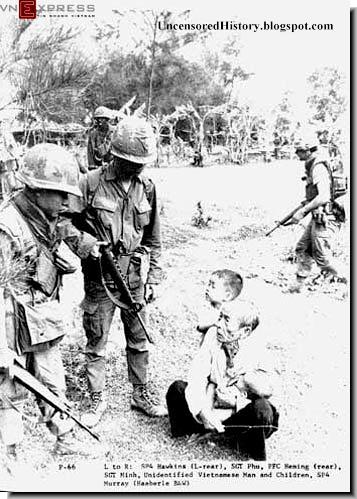 |
| An old man and a child are threatened |
This changed in 1970, for I was accepted to attend my local school. What a bittersweet moment for me — my dream had been achieved, but at a cost. How I longed for my parents to see me attend class, even though our hunger pains became inexcruciable. The worst times occurred when we literally starved because there was no rice to be found. Eventually, we resorted to stealing wheat bulbs, a kind of sweet potato, from the garden of a local resident, Mrs. Ran.
Such tactics became more commonplace. My sisters worked harder to get more food because our grandmother was no longer able to travel to the market to buy and sell goods. My two sisters and I shared responsibilities for her wellbeing. My older sister My, who by 1972 was in third grade in the local high school in Long Tang, dropped out of classes, something she did reluctantly. Ha and I worked in the fields after school and would bring back some rice and sweet potatoes, but when Ha came home one night, we were shocked by her appearance. She was dirty, looked unhealthy, and often went without meals. By contrast to the amount of rice and other foods that Ha and I consumed, my older sister took very little.
At the end of 1972, Son Hoi continued to resemble a battlefield, and my entire family in Son Tinh Hoi An had to be evacuated. When the fighting had temporarily ceased a few weeks later, the signs seemed promising — maybe the war would finally stop. However, a bomb from a U.S. fighter plane destroyed my grandmother’s house, with a large crater hole evidence of its destruction. Thankfully we were all safe and accounted for, although it took us two months to erect another bamboo house that yet again seemed far from being a home. War instills a legacy of fear, that nothing is permanent.
My siblings, grandmother and I ventured towards the coast, looking for rice seeds in the fields along the way as part of returning to a stable routine. In Soi Hon, I saw my friends enjoy their childhood, laughing together as they flew kites and played football in the fields. This life is one I could have only dreamed of, but I resigned to letting them go, thus cutting off my communication with them. Survival was my first goal. If I acted in a carefree manner, then neither my family nor myself would have food to eat.
This war had deprived me of many things; half of my family, my childhood, and my innocence. Here I stood, a boy forcefully thrown into the life of an adult possessing only a discoloured hat and rags as clothes, a hoe in which to dig the earth and a Korean-made bag to carry whatever I owned. I had no money to buy even the smallest of items.
In the two years leading up to Vietnam’s reunification, I became obsessed with finding any long lost relatives that may have survived the war. My father’s fate was still unclear, but I guessed that having spent so long in the mountains, there must be a chance that he could still be alive, for soldiers were often away for long periods of time. I was excited when at the sight of seeing Hong, a long-time friend and son of a local man Mr. Ho. But this feeling of ecstasy was cut short when I received a visit from my father’s friend, Mr. Phan The Manh, who held a high rank in the resistance unit.
“Your father was a very brave man and sacrificed himself heroically,” he said, and immediately consoled me. These few words confirmed my worst fears. My father was shot and killed by American soldiers when his ambulance team attempted to help a wounded fighter. It was a crushing blow for me; I remembered his message about the importance of learning and making the most of every opportunity.
When I learned that I would be elevated from the sixth grade at Son Hoi school to attend a higher level in nearby Son Hoi Thanh, the pride and joy that I felt was immense. But the teacher turned me away from class on the first day because I did not wear long pants. If only she knew just how difficult life had been for me up until this point, then maybe her heart would have been kinder. When I went home and relayed the news, it must have seemed like just another setback. But this one seemed more significant. My aunt gave me a pair of black khaki pants once owned by her late husband, and for the first time I now possessed my first pair of long pants and could attend school. After three lessons, the teacher who refused to let me into class was reduced to tears when I told her what had become of my family. What more could one do?
Part III
History books will tell you that on April 30, 1975, the tanks rolled into Saigon, signalling the end of Vietnam’s war and that my fellow people could start to rebuild their lives. But the difficulties of years gone by were not automatically erased from my memory, like the time when I was nearly beaten to death while collecting crops.
Some of my family began moving back to our former village of Son My, ending my two year absence. This meant that I commenced attending a local school. Compared to my classmates, I was relatively large, but this did not stop my obsession with hunting for extra food to supplement our diet. One afternoon, two of my friends, Dinh and Lien, joined me in trekking into the mountains in hope of harvesting potato tubes, but our afternoon’s toiling yielded no potatoes or Oi [a Vietnamese fruit]. As the sun set in the distance, we walked down the mountain and to our good fortune, stumbled upon a dense clump of tubers, which were very good. All three of us cleared the grass to create a path and in front of us were plenty of onion bulbs to collect. Within a short time, we collected half a bag full. But up ahead we spotted a young man armed with a stick that he used to collect bags and we immediately we sensed danger.
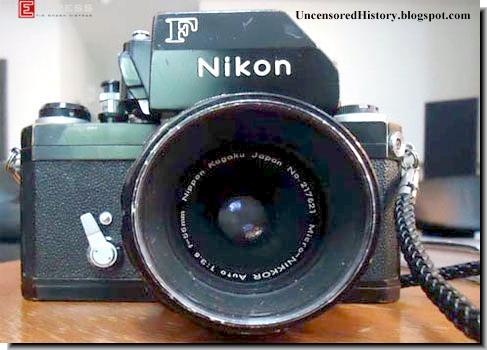 |
| The old mechanical camera of Ronald Haeberle that captured the massacre on film for posterity |
Our first instincts were to lay low in the long grass in the hope that we would not be discovered, but I was caught and without having any chance to think about what punishment awaited me, I found a hoe being pointed in my face. The man pulled me out of the grass roughly and used the hoe to beat me in the stomach, and across my shoulder and back. I cannot remember how long the beating lasted because I had passed out, but it ceased only when my body stopped twitching. All the food my friends and I had gathered was handed back to the man who inflicted the beating. My whole body was swollen and I was unable to attend school or work in the field. When my sister Mỹ and my grandmother asked what had happened, I told only half of the story. The man who inflicted the thrashing, it turned out, lived behind the house of our family friend, Mrs. Bon Thuong. My sister recognised him and other young people he associated with quite often. To this day, I believe that he feels guilty about the incident. Maybe it is because he instigated the attack and now realizes that I have no desire to seek revenge.
My pain and anger is not aimed at only those who took the lives of my family members, but at those who have covered up mistakes years after and have refused to say anything to me. Many reporters from around the world have come to My Son. They have worked with the Quang Ngai municipal staff in their offices and talked several times about the deceased. But I believe the media has been misled by authorities on certain matters. A number of survivors and their relatives have never been asked about their wishes. These include Mrs. Pham Thi Tro, daughter of Mrs. Nhieu, Le Thi Em, Pham Thi Hien, Bui Thi Ha, and Bui Sanh, the grandson of Mr. Huong Tho. They still live less than 800 yards from the memorial house, each one in dire poverty.
You only need look at photographs of the victims taken by U.S. Army officer Mr. Ronald Haeberle. These include:
Mrs. Nguyen Thi Tau, photographed with her closed mouth covered by a straw hat, may have lost her children but this certain that many soldiers have shot her children. Two of them were saved.
Mr. Nhieu’s wife and daughter escaped through the back door of their hut and hid in the rice field. They were lucky to flee, for five members of their family were killed. They also witnessed many gruesome images and experiences in their home.
Mrs. Pham Thi Thuan lost five people in her family, all killed by gunshots. I estimate that about 20 people who ran from the corner of her house sought shelter in the ditch, or other lay down in the garden. Others were hiding behind the altar where the family burned incense and gave offerings to their ancestors. They were all pulled out and shot by U.S. soldiers.
Mrs Thi Tuyet Do lives in Pleiku. She and her family were pulled out by U.S. soldiers and ordered to sit in front of the house before being instructed to enter the ditch. Of the 170 people, most in the line of fire were women and children. Many of them were killed, but you survived if you were covered by the other bodies.
Mr. Dat Pham testified that his wife was shot and injured, while a seven month-old child crawled out of a burning house and wandered towards the ditch; the child was shot by U.S. soldiers, covered in dry leaves, and burned.
Ms. Truong Thi Le lived because she lay quiet underneath two dead bodies and pretended to be dead.
Ha Thi Qui is now 83 years old and was wounded in the hip and lay there quietly, also underneath corpses. She later attempted to crawl home. On the way, she saw many injured persons and bodies of women, some of whom had been raped by U.S. soldiers and then shot.
I saw Mrs. Pham Thi Trinh, then 11 years old try to crawl out of the ditch to the top, just like Mrs. Pham Thi Muoi, whom was only 14 years old when she was found next to a house, raped and shot dead by a U.S. soldier.
A mother and 7 month old child were covered in dry leaves and set alight by U.S. soldiers.
The house of Mr Le contained 15 hidden people who were found and thrown in the trenches. Nobody was spared.
Ms. Trinh’s eight year-old daughter was shot by U.S. soldiers when attempting to escape a ditch while carrying a mouthful of rice.
Mr Tấn Huyen Tran, from Khe Thuan village, said that his grandparents, his parents, and child were shot dead by U.S. soldiers.
Many people from the international press have come with their camera crews to film stories about My Lai in the past. Authorities paid members of the press to stay about 800 yards away from areas where the poorest survivors and their families lived, to discourage any contact and prevent details being released. Film director Oliver Stone worked in Pinkville with an interpreter, dealing with the press to obtain details for making his film. But our testimony and history has been ignored. My family received no help from the community or the state. After Vietnam became a united country, I learned that my mother’s tombstone had been issued with the wrong date of birth and even worse, the incorrect picture. When I raised this with house memorial officials, they did not take up my complaints further. Perhaps my stories of a handful of cold rice and going numerous days without food in my childhood interfered with their seemingly lavish lifestyle.
For any of the 130 American soldiers involved in the massacre, people such as Ernest Medina, William Calley, Oran K. Henderson, Samuel W. Koster, Eugene Kotouče, have you considered what impact your actions had on the children who lost their parents? Some of these children are now adults and they still live with the nightmares of being dragged out of their huts, being thrown into ditches, and watching machine guns and grenades slaughter their family members. After 42 years, you still have not come back to seek redemption. What did the innocent people of Son My and the surrounding hamlets do wrong to deserve being killed? How many screaming children can you recall crawling or lying on the ground in a puddle of blood? When you opened fire, mothers were breastfeeding children. Elderly village women and defenceless and unarmed men died with frightened looks in their eyes. People that we respected and paid reverence to, you spat in their faces. You raped teenage girls and young women. Before committing your evil deeds, your units slowly encircled us, preventing any chance of escape.
Maybe you do not care, in which case, an apology is useless.
However, there were some soldiers who showed compassion and I would publicly like to thank them. These people include Mr. Ronald Haeberle, who took a photo of my mother and other images from his helicopter. These include the two pictures of the four young children he photographed before they were shot by U.S. soldiers, and another of two children lying on the street. The people of Son My remember him very fondly for his actions to prevent further loss of life. I also pay my respects to Hugh Thompson, who landed his helicopter to rescue an eight-year old child and take her to a hospital after receiving a radio call from Glenn Andreotta. Larry Colburn, Ron Ridenhour, Seymour Hersh (the investigative journalist who exposed the My Lai Massacre to the world in 1969) and William R. Peers all tried to tell the world exactly what took place, but were silenced by the U.S. government.
Although I now reside in Germany, I am speaking up on behalf of the residents who continue to live in My Lai and remain committed to seeing justice prevail for the deceased and survivors.











